2017 Hyundai Elantra engine
[x] Cancel search: enginePage 4 of 571

F4
FOREWORD
Thank you for choosing HYUNDAI. We are pleased to welcome you to the growing number of discriminating people who
drive HYUNDAI. The advanced engineering and high-quality construction of each HYUNDAI we build is something of
which we're very proud.
Yo u r O w n e r ' s M a n u a l w i l l i n t r o d u c e y o u t o t h e f e a t u r e s a n d o p e r a t i o n o f y o u r n e w H Y U N D A I . I t i s s u g g e s t e d t h a t y o u r e a d
it carefully because the information it contains can contribute greatly to the satisfaction you receive from your new vehi-
cle.
The manufacturer also recommends that service and maintenance on your vehicle be performed by an authorised
HYUNDAI dealer.
HYUNDAI MOTOR COMPANY
Note :Because future owners will also need the information included in this manual, if you sell this HYUNDAI, please
leave the manual in the vehicle for their use. Thank you.
Copyright 2015 HYUNDAI Motor Company. All rights reserved. No part of this publication may be reproduced, stored
in any retrieval system or transmitted in any form or by any means without the prior written permission of HYUNDAI
Motor Company.
Severe engine and transmission damage may result from the use of poor quality fuels and lubricants that
do not meet HYUNDAI specifications. You must always use high quality fuels and lubricants that meet the
specifications listed on Page 8-6 in the Vehicle Specifications section of this Owner's Manual.
CAUTION
Page 7 of 571

F7
Introduction
NOTICE indicates a situation
which, if not avoided, could result
in vehicle damage.
Petrol engine
Unleaded
Yo u r n e w v e h i c l e i s d e s i g n e d t o u s e
only unleaded fuel having an Octane
Rating of RON (Research Octane
Number) 91 or higher. Do not use
methanol blended fuels.
Yo u r n e w v e h i c l e i s d e s i g n e d t o
obtain maximum performance with
UNLEADED FUEL, as well as min-
imise exhaust emissions and spark
plug fouling.
NOTICE
•Do not "top off" after the noz-
zle automatically shuts off
when refuelling.
•Always check that the fuel cap
is installed securely to pre-
vent fuel spillage in the event
of an accident.
WA R N I N G
NEVER USE LEADED FUEL.
The use of leaded fuel is detri-
mental to the catalytic converter
and will damage the engine
control system’s oxygen sensor
and affect emission control.
Never add any fuel system
cleaning agents to the fuel tank
other than what has been spec-
ified. We recommend that you
consult an authorised HYUNDAI
dealer for details.
CAUTION
CAUTION indicates a hazardous
situation which, if not avoided,
could result in minor or moder-
ate injury.
CAUTION
FFUUEELL RREEQQUUIIRREEMMEENNTTSS
Page 8 of 571
![Hyundai Elantra 2017 Owners Manual - RHD (UK. Australia) F8
Introduction
Petrol containing ethanol
Ethanol [E-10], a mixture of petrol
and ethanol (also known as grain
alcohol), is marketed along with or
instead of leaded or unleaded petrol Hyundai Elantra 2017 Owners Manual - RHD (UK. Australia) F8
Introduction
Petrol containing ethanol
Ethanol [E-10], a mixture of petrol
and ethanol (also known as grain
alcohol), is marketed along with or
instead of leaded or unleaded petrol](/manual-img/35/14544/w960_14544-7.png)
F8
Introduction
Petrol containing ethanol
Ethanol [E-10], a mixture of petrol
and ethanol (also known as grain
alcohol), is marketed along with or
instead of leaded or unleaded petrol.
Do not use petrol containing more
than 10% ethanol, and do not use
petrol or ethanol containing any
methanol. Either of these fuels may
cause drivability problems and dam-
age to the fuel system, engine con-
trol system and emission control sys-
tem.
Discontinue using ethanol of any
kind if driveability problems occur.
Ve h i c l e d a m a g e o r d r i v e a b i l i t y p r o b -
lems may not be covered by the
manufacturer’s warranty if they result
from the use of:
1. Petrol containing more than 10%
ethanol.
2. Petrol or ethanol containing
methanol.
3. Leaded fuel or leaded ethanol.
Other fuels
Using fuel additives such as:
-Silicone fuel additive
-MMT (Magnanese, Mn) fuel additive
-Ferrocene (iron-based) fuel additive
-Other metallic-based fuel additives
may result in cylinder misfire, poor
acceleration, engine stalling, dam-
age to the catalytic converter, or
abnormal corrosion, and may cause
damage to the engine resulting in a
reduction in the overall life of the
powertrain.
Damage to the fuel system or per-
formance problems caused by the
use of these fuels, may not be cov-
ered by your New Vehicle Limited
Warranty.
NOTICE
Never use fuel which contains
methanol. Discontinue use of
any petrol containing ethanol
which impairs drivability.
CAUTION
Page 9 of 571
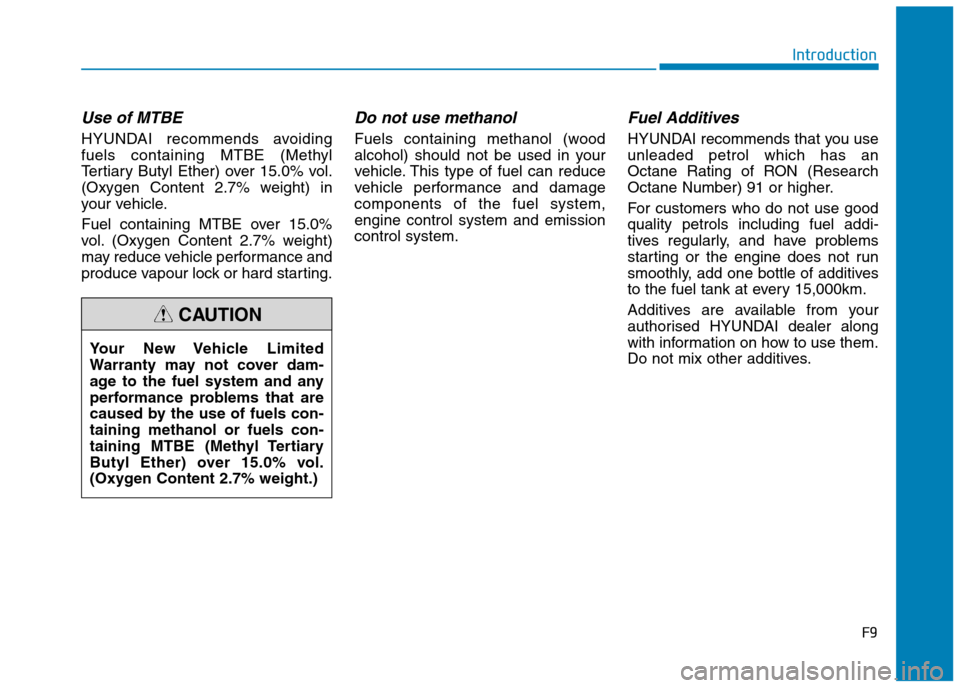
F9
Introduction
Use of MTBE
HYUNDAI recommends avoiding
fuels containing MTBE (Methyl
Te r t i a r y B u t y l E t h e r ) o v e r 1 5 . 0 % v o l .
(Oxygen Content 2.7% weight) in
your vehicle.
Fuel containing MTBE over 15.0%
vol. (Oxygen Content 2.7% weight)
may reduce vehicle performance and
produce vapour lock or hard starting.
Do not use methanol
Fuels containing methanol (wood
alcohol) should not be used in your
vehicle. This type of fuel can reduce
vehicle performance and damage
components of the fuel system,
engine control system and emission
control system.
Fuel Additives
HYUNDAI recommends that you use
unleaded petrol which has an
Octane Rating of RON (Research
Octane Number) 91 or higher.
For customers who do not use good
quality petrols including fuel addi-
tives regularly, and have problems
starting or the engine does not run
smoothly, add one bottle of additives
to the fuel tank at every 15,000km.
Additives are available from your
authorised HYUNDAI dealer along
with information on how to use them.
Do not mix other additives.Yo u r N e w Ve h i c l e L i m i t e d
Warranty may not cover dam-
age to the fuel system and any
performance problems that are
caused by the use of fuels con-
taining methanol or fuels con-
taining MTBE (Methyl Tertiary
Butyl Ether) over 15.0% vol.
(Oxygen Content 2.7% weight.)
CAUTION
Page 10 of 571
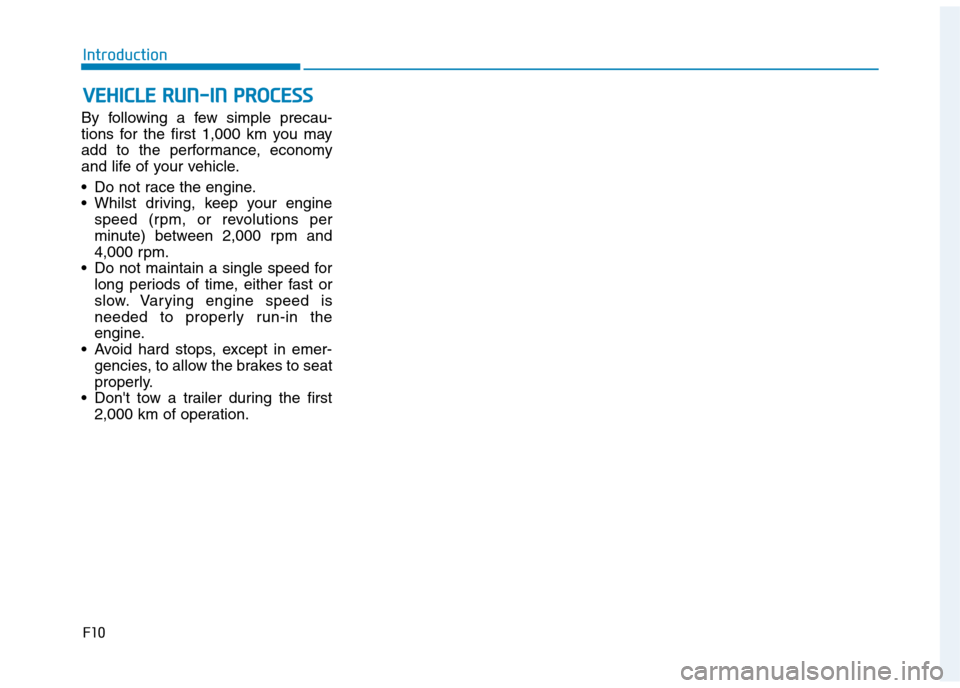
VVEEHHIICCLLEE RRUUNN--IINN PPRROOCCEESSSS
F10
Introduction
By following a few simple precau-
tions for the first 1,000 km you may
add to the performance, economy
and life of your vehicle.
•Do not race the engine.
•Whilst driving, keep your engine
speed (rpm, or revolutions per
minute) between 2,000 rpm and
4,000 rpm.
•Do not maintain a single speed for
long periods of time, either fast or
slow. Varying engine speed is
needed to properly run-in the
engine.
•Avoid hard stops, except in emer-
gencies, to allow the brakes to seat
properly.
•Don't tow a trailer during the first
2,000 km of operation.
Page 12 of 571
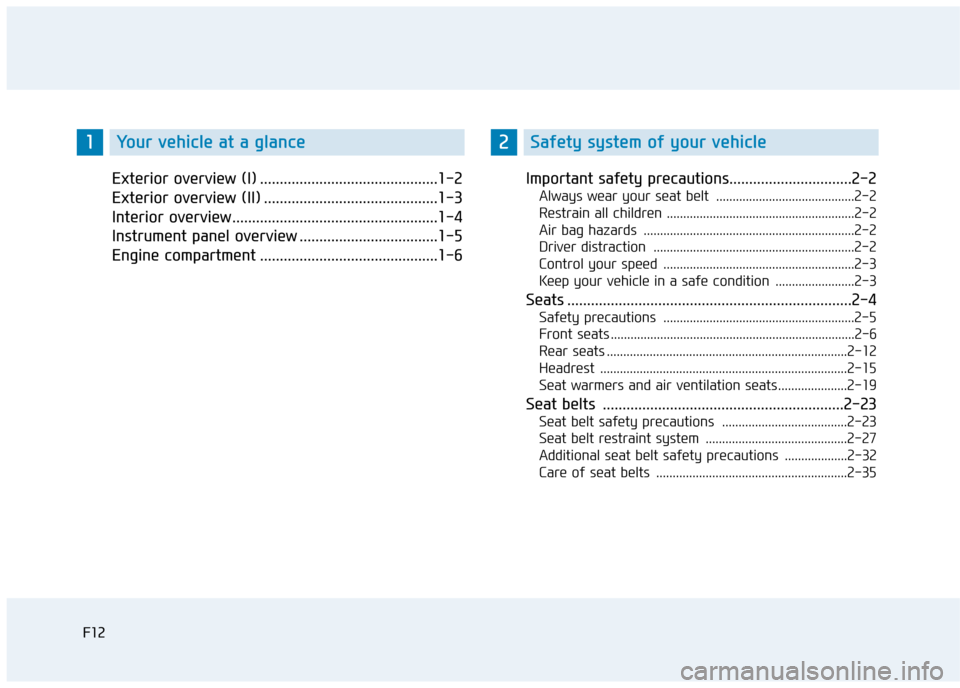
F12F12
Exterior overview (I) .............................................1-2
Exterior overview (II) ............................................1-3
Interior overview ....................................................1-4
Instrument panel overview ...................................1-5
Engine compartment .............................................1-6
Important safety precautions...............................2-2
Always wear your seat belt ..........................................2-2
Restrain all children .........................................................2-2
Air bag hazards ................................................................2-2
Driver distraction .............................................................2-2
Control your speed ..........................................................2-3
Keep your vehicle in a safe condition ........................2-3
Seats ........................................................................2-4
Safety precautions ..........................................................2-5
Front seats ..........................................................................2-6
Rear seats .........................................................................2-12
Headrest ...........................................................................2-15
Seat warmers and air ventilation seats.....................2-19
Seat belts .............................................................2-23
Seat belt safety precautions ......................................2-23
Seat belt restraint system ...........................................2-27
Additional seat belt safety precautions ...................2-32
Care of seat belts ..........................................................2-35
1Yo u r v e h i c l e a t a g l a n c e2Safety system of your vehicle
Page 17 of 571
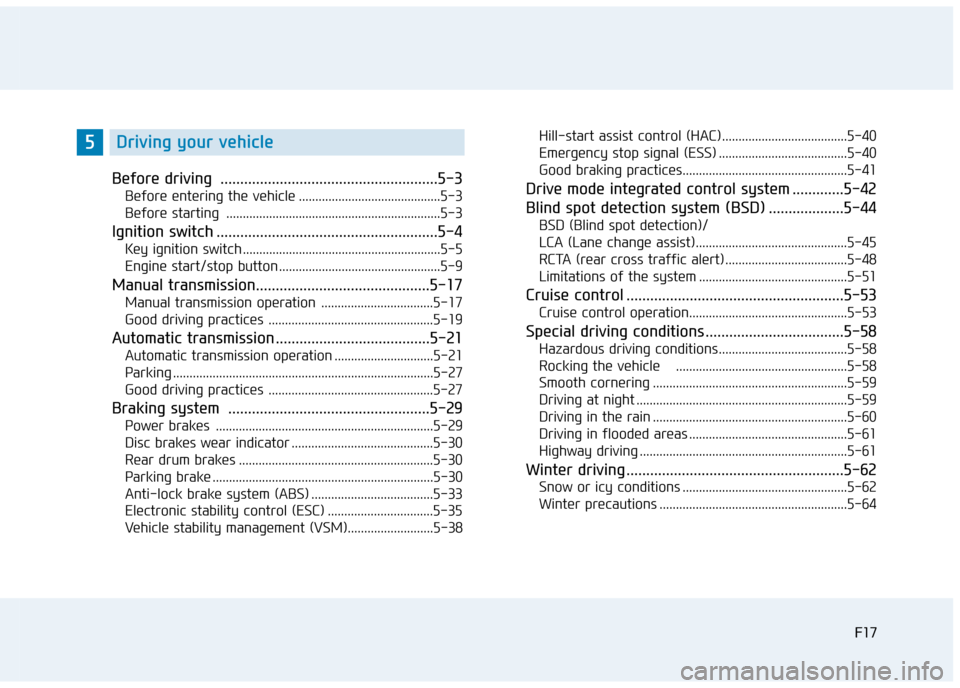
F17F17
Before driving .......................................................5-3
Before entering the vehicle ...........................................5-3
Before starting .................................................................5-3
Ignition switch ........................................................5-4
Key ignition switch ............................................................5-5
Engine start/stop button .................................................5-9
Manual transmission............................................5-17
Manual transmission operation ..................................5-17
Good driving practices ..................................................5-19
Automatic transmission .......................................5-21
Automatic transmission operation ..............................5-21
Parking ...............................................................................5-27
Good driving practices ..................................................5-27
Braking system ...................................................5-29
Power brakes ..................................................................5-29
Disc brakes wear indicator ...........................................5-30
Rear drum brakes ...........................................................5-30
Parking brake ...................................................................5-30
Anti-lock brake system (ABS) .....................................5-33
Electronic stability control (ESC) ................................5-35
Ve h i c l e s tab i l i t y m a n a g e m e n t ( V S M ) . . . . . . . . . . . . . . . . . . . . . . . . . . 5 - 3 8
Hill-start assist control (HAC) ......................................5-40
Emergency stop signal (ESS) .......................................5-40
Good braking practices..................................................5-41
Drive mode integrated control system .............5-42
Blind spot detection system (BSD) ...................5-44
BSD (Blind spot detection)/
LCA (Lane change assist)..............................................5-45
RCTA (rear cross traffic alert) .....................................5-48
Limitations of the system .............................................5-51
Cruise control .......................................................5-53
Cruise control operation................................................5-53
Special driving conditions ...................................5-58
Hazardous driving conditions.......................................5-58
Rocking the vehicle ....................................................5-58
Smooth cornering ...........................................................5-59
Driving at night ................................................................5-59
Driving in the rain ...........................................................5-60
Driving in flooded areas ................................................5-61
Highway driving ...............................................................5-61
Winter driving .......................................................5-62
Snow or icy conditions ..................................................5-62
Winter precautions .........................................................5-64
5Driving your vehicle
Page 18 of 571
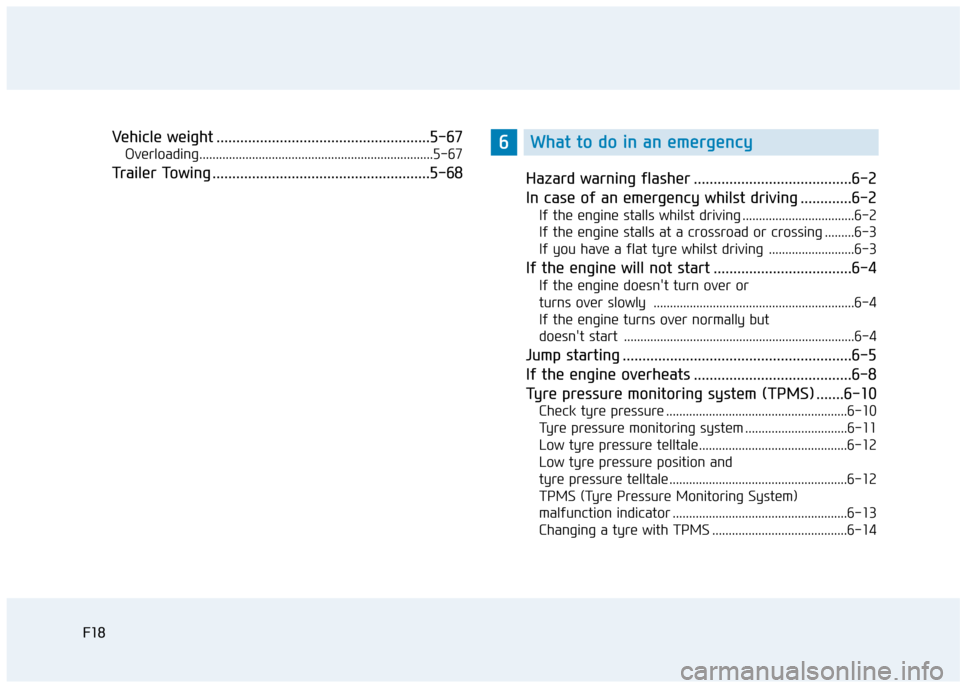
F18
Ve h i c l e w e i g h t . . . . . . . . . . . . . . . . . . . . . . . . . . . . . . . . . . . . . . . . . . . . . . . . . . . . . . 5 - 6 7
Overloading.......................................................................5-67
Tr a i l e r To w i n g . . . . . . . . . . . . . . . . . . . . . . . . . . . . . . . . . . . . . . . . . . . . . . . . . . . . . . . 5 - 6 8Hazard warning flasher ........................................6-2
In case of an emergency whilst driving .............6-2
If the engine stalls whilst driving ..................................6-2
If the engine stalls at a crossroad or crossing .........6-3
If you have a flat tyre whilst driving ..........................6-3
If the engine will not start ...................................6-4
If the engine doesn't turn over or
turns over slowly .............................................................6-4
If the engine turns over normally but
doesn't start ......................................................................6-4
Jump starting ..........................................................6-5
If the engine overheats ........................................6-8
Ty r e p r e s s u r e m o n i t o r i n g s y s t e m ( T P M S ) . . . . . . . 6 - 1 0
Check tyre pressure .......................................................6-10
Ty r e p r e s s u r e m o n i t o r i n g s y s t e m . . . . . . . . . . . . . . . . . . . . . . . . . . . . . . . 6 - 1 1
Low tyre pressure telltale.............................................6-12
Low tyre pressure position and
tyre pressure telltale ......................................................6-12
TPMS (Tyre Pressure Monitoring System)
malfunction indicator .....................................................6-13
Changing a tyre with TPMS .........................................6-14
F18
6What to do in an emergency